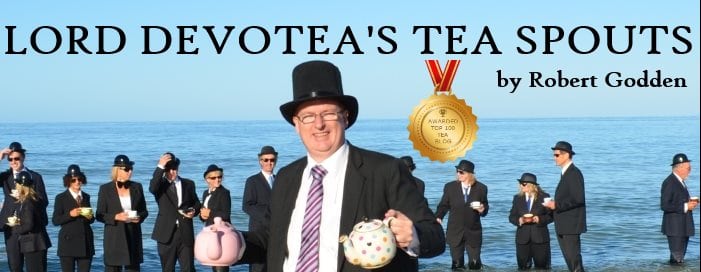THE FOLLOWING IS AN EXCERPT FROM A DRAFT OF MY FORTHCOMING BOOK. COMMENTS WELCOME
Think of a Darjeeling. Any Darjeeling. I’ll bet it was Margaret’s Hope! Am I right? You know I’m right.
Surely this is the most well known of the single origin Darjeelings! All around the world, people know this tea.
I hope it’s not like the famed Australian Barramundi – a fish which is sold in 3 times the quantities it is caught. Tea substitution is widespread, and this would be an obvious target.
I find it’s a tea that evolves – just when you get used to one crop, the next years has a different profile. This year (2011) I’m finding it more Darjeelingingy, whereas often it’s a touch Assamese, in quality if not actuality.
“But…”, I hear you cry “Giddephar / Castleton / Risheehat /Arya”.
We all have our favourites – well, any tea drinker of note who isn’t caught up in the grassy, thin, bitter window cleaner that passes for Japanese Tea – and indeed, my great Darjeeling love is at this moment the Giddephar estates.
But Margaret’s Hope is pervasive. It’s ubiquitous. It’s the gateway into Darjeeling tea, it’s the Single Estate you can get anywhere.
The Autumnal and Second Flush are quite strong by Darjeeling standards, and so, can be a great way to ease into the delicate pleasure if what some people call “the champagne of tea”. I myself would never even compare a bottle of bubbly stale grape juice to the glory of a good tea.
The “Margaret” in question loved the place, but died on board a ship for England of an unspecified tropical disease. Her grieving father – preserved in history as “Mr Cruikshank” renamed the garden in 1927; he was the then owner of the North Kurseong estate. Since its beginnings in 1830 it had been known as “Bara Ringtong”, which according to my detailed knowledge of the local dialect, means Big , er, Ringtong.
We’ll never know whether it could have achieved the same appeal in the western markets under that name, which sounds to my post-colonial ear like a Spike Milligan nonsense song.

You bring up an interesting thought about the profile of a given tea garden from year-to-year. Given the proximity of Darjeeling to Assam, I wonder if the original tea, back in the Bara Ringtong days, would have had the same characteristics, or if what we know as a Darjeeling or an Assam are actually two hybrid cultivars of the same crop that have just evolved in slight ways? The current focus on genetically-modified seeds here in the State has brought to light how easily one plant can overtake a field. I wouldn’t be surprised, given the politics of tea in that region, if there weren’t more shenanigans happening of that sort.
It’s one of the reasons they’re so strict about things in the region of Champagne, too many copycats or imitations lurking about or threatening to cross-breed. (Yes, I’m a confessed green tea appreciater and I’ve traveled in and enjoyed glasses of true Champagne, but don’t hold that against me!)
I agree that Champagne should jealously protect their image. After all, when you consider how many nuclear power plants there are in that province, these guys obviously know a thing or two about agriculture.
@latteteadah:
While Assam does indeed border Darjeeling, the elevation of the two couldn’t be more different. Assam teas are grown around sealevel (and up to a few hundred meters), while most Darjeelings grow between 800 and 1700m.
A lot of the varietals used in Darjeeling are of Chinese origin (with an certain, but increasing amount of Assam clonals), while the bushes in Assam are – well, you know it – of the Assam variety.
When the Brits tried to establish their tea industry in India in the early 19th century, they initially failed – because they used the (newly discovered) Assam variety in the high elevations of the Himalayas. It wasn’t until they smuggled Chinese seedlings into the Darjeeling area, that their high-mountain production succeeded.
“Giddephar / Castleton / Risheehat /Arya”
If you’d included Makaibari, that would’ve been all my favorites. I’ve had a couple of Margaret’s Hopes and liked ’em quite a bit. Even passed them on to my mother, and she agreed.
Coincidentally, she is a Margaret.
Interesting little story about the tragic Margaret. Not a story I’m likely to forget. In the little tidbits I read about this girl, there’s confusion about the owner of the estate though. Some articles do refer to him as Mr Cruikshank but others as Mr Bagdon. What gives? Maybe see what you can dig up about this?
As to Margaret’s Hope, I have a feeling it is, or certainly was one of @lahikmajoe‘s favorites, but for me it’s one of the lesser enjoyable ones. Don’t get me wrong, I really like Darjeelings. But as you said, it’s probably one of the most common ones in tea stores, but I never really took to it. It wasn’t until I tasted teas from other Darjeeling estates that I truly fell in love with this tea.
@yaya – thanks for your geographical input. Always good to be reminded of elevations in the region. Anyway, @latteteadah those were some interesting thoughts of yours, thank you!
Anyway Robert, your previews are quite fascinating…can you tell us more about the context, or generally more about your book? And please keep on dropping in little excerpts here, they are both fun and interesting to read!
Thanks for sharing this with us. It was fun to read.